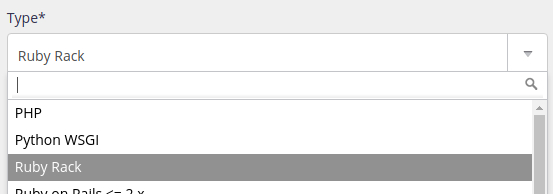Configuring Ruby
[package] and [version] have to be replaced by the name of the package and version to be installed.
Supported versions
| 3.4 | 3.3 | 3.2 | 3.1 | 3.0 |
| 2.7 | 2.6 | 2.5 | 2.4 | 2.3 | 2.2 | 2.1 | 2.0 |
| 1.9 | 1.8 |
The default version can be changed from the administration section, under Environment > Ruby. This is the version that is especially used when you start ruby.
Versions are not necessarily already installed.
Error logs
You can view the error logs in the $HOME/admin/logs/uwsgi/[id].log file where [id] is the identifier for your site, shown in the Web > Sites section.
An extract of these logs is presented in the administration’s interface (Logs - 📄).
Binary to use
You need to always use ruby (or /usr/bin/ruby). Never use ruby2.4 or any other command.
To force the use of a different version of Ruby other than the default one, define the environment variable RUBY_VERSION:
$ RUBY_VERSION=2.3 rubyIn your scripts, use /usr/bin/ruby as shebang:
#!/usr/bin/rubyTo force the use of a specific version of Ruby:
#!/usr/bin/eval RUBY_VERSION=2.3 rubyThe other binaries included in Ruby (gem, irb, ri, etc.) work the same way.
Environment
Your Ruby environment starts off empty, with no ready installed libraries other than the standard library.
Installing a package
You can use gem to install packages:
$ gem install [package]Packages are installed in the standard $HOME/.gem directory and they are automatically added to load path by Ruby.
Note that you will need to re-install the packages if you change the major Ruby version (versions 2.3 and 2.4 are two different major versions, whereas 2.3.1 and 2.3.0 use the same major version).
You can specify a specific version:
$ gem install [package] -v [version]Uninstalling a package
$ gem uninstall [package]Using Bundler
We recommend using Bundler if you use a number of different Ruby applications so that each one has its own separate environment. Bundle installs the packets listed in a Gemfile.
$ bundle installHTTP deployment
To make a Ruby application accessible over the web, you need to add a site in the Web > Sites section of the alwaysdata administration. We offer the Ruby Rack type which uses the uWSGI web server.

- type: choose Ruby Rack,
- application path: the path to your Rack application.
You can also fill-in a number of optional fields:
- use Bundler,
- environment variables to define,
- a specific version of Ruby to use.
You can use another web server by launching it as a User Program type.